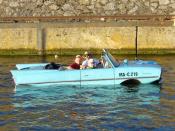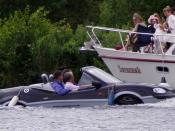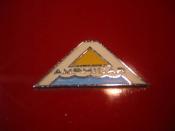Amphibious means able to operate both on land and in water. Amphibious cars could one day be an ordinary thing. Who wouldn't want the ability to transform their car into a jet-powered boat at the touch of a button? The history, production, specifications, and our personal design for a Lancer-Amphibian shall be explained in this research report.
The history of the amphibious car is comparable to that of the car itself. Even as the car was in its early stage and still being introduced people wanted something that could travel on both land and water. Projects as early as 1899 showed us that vehicles could go both on land and water. Over 194 vehicles that are road and seaworthy (or were designed to be), and intended for passenger carrying. This number includes prototypes and cars, but not trucks, ATVs, or other working machines.
The first motorized attempt at an amphibian, the Magrelen Amphibium was built in Denmark, it used a combustible engine.
This car and many others used the motor to power paddle wheels in the back of the car. Others had no propulsion and were just "floaters". Hannes Trippel, who designed several amphibious cars for Germany, created the TRIPPEL SG6 (1937). The SG6 intended mainly for military use army. Trippel was also involved in the Amphicar, described later.
The Hydromobile, built in 1942 by a Hungarian engineer in the United States, had a wooden hull. It boasted high-speed performance in water and retractable wheels that improved speed and reliability. The Half-Safe, created by Carlin, was an USA modified Ford GPA. Carlin crossed the Atlantic Ocean in it and circumnavigated around the world.
Although not too successful, the Voiture de Bled, engineered by Frenchman Petit, was one of the first jet-driven amphibians.
The Amphicar (1961) was perhaps the most successful...



You ask. . .
"Who wouldn't want the ability to transform their car into a jet-powered boat at the touch of a button?"
Answer: Anyone who lives nowhere near water.
Duh.
0 out of 0 people found this comment useful.